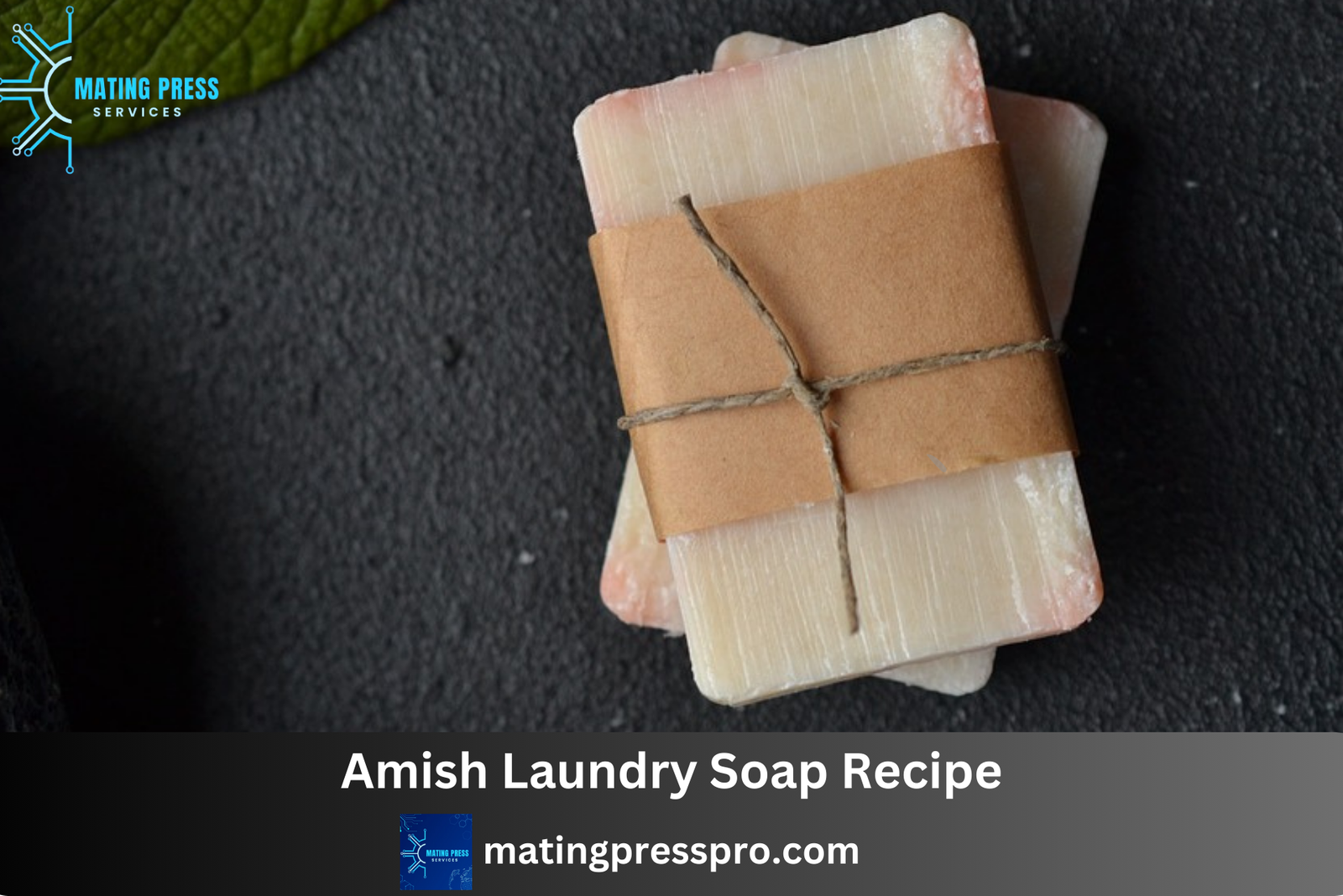Amish Laundry Soap Recipe

Recent studies show that individuals are reaching out for less synthetic and more natural products. One of them includes Amish Laundry Soap Recipe – a more of a home made traditional natural soap handed down the generations until now this has not soaked its effectiveness. In this article, we’ll take you through the complete process of making Amish Laundry Soap Recipe from A-Z, starting from the ingredients and the steps down to tips that will enhance the soap’s cleansing power. It will also elucidate on the reasons why you will opt for this kind of soap in relation to your health and the environment.
The Benefits of Natural Cleaning Products
In recent years, consumers have become aware of the health hazards posed by traditional cleaning products and their effects on the environment. It is common for consumers to use store bought laundry detergent which often contains harsh chemicals, synthetic fragrances and dyes all of which will often be irritating to the skin and cause other allergic reactions, irritations, and other risks especially to the sensitive skin or people with some types of sensitive allergies. In addition, these detergents are often as a result of wastewater that contains a lot of toxins and other environmental pollutants.
Thus, it is no surprise that people are seeking a better alternative in the form of Amish laundry soap that is natural and homemade. Affordable, effective, and biodegradable, Amish laundry soap is a green cleaning product that simply does not come with any toxins, and rather does the job of washing clothes.
Why Did We Go For Amish Laundry Soap Recipe?
The base of the Amish laundry soap is as basic as it can get, fitting in very well with the philosophy held by the Amish community of being self-sufficient and using alternatives to modern conveniences sparingly. As a result of the practicality of this recipe, it has over the years been part and parcel of Amish household practices.
Benefits of Using Amish Laundry Soap Recipe
- No Toxins: Amish loundry soap is a few ounces of soap made from some natural ingredients and not refined with any toxic chemicals, artificial ingredients like many detergents out there in the market.
- Saves Money: Being that you have to make your own laundry soap, operating costs will drop significantly, and by hundreds of dollars annually compared to the purchase of commercial detergents.
- Non Abbrasive To Clothes: Most clothes soap is drying because of the composition that would fasten the development of corrosive elements, and therefore causing damage to fabrics.
- Safe for Users with Delicate Skin: This soap does not contain irritating chemicals or fragrance, hence not conducive for causing irritations, hence recommended for people with delicate skin or those suffering from eczema or allergic skin.
- Puts No Strain on the Environment: There is also no harm to the environment with misuse of smelly money, as Amish laundry detergent is biodegradable and developed from simple flora.
What Are the Ingredients of the Best Amish Laundry Soap Recipe
There are several factors as to why the Amish laundry soap recipe has endured over the years and most of them can be attributed to the easy to use and readily available ingredients. Here is an explanation of the various components featured in the recipe and their function towards the production of the soap.
1. Fels Naptha Soap
Each and every Amish laundry soap recipe relies on the use of Fels-Naptha soap, which is a hard bar laundry soap that has been available for more than hundred years. It was earlier used for removing laundry stains but Fels-Naptha is known to dissolve grease and oil fairly well and it works well as a stain fighter. Shredded and heated, this soap acts as the main ingredient of the homemade cleaner.
- Key Function: It helps to remove stains, dirt and grease from the clothes.
- Alternative: Another option is using a bar of castile soap or any other mild soap bar should there be no Fels-Naptha available.
2. Washing Soda
Also referred to as Sodium carbonate, washing soda is a very important compound when making soap. It is a very effective water softener and therefore boosts the effectiveness of soap particularly in hard water areas. Further, it assists in the removal of stubborn stains and is a superb wash for clothes.
– Key Function: Softens water, enhances effectiveness and removes soil and dirt.
– Availability: There are many shops from where washing soda can be bought or one can make it by baking baking soda at higher temperatures.
3. Borax
Also is naturally occurring minerals, borax is often used for cleaning products and cleaning clothes. In Amish laundry soap borax is termed as laundry booster which increases alkalinity of soap making its cleansing ability better. It also has stain removing properties, clothes deodorizer and a disinfectant.
– Key Function: Retainment of stains, enhancement of cleaning and deodorization.
– Caution: Borax is a naturally occurring mineral compound hence precautions should be taken in its handling and storage and should be out of reach from children and pets.
4. Water
Water is the common source that acts to dissolve the soap, as well as combine the other ingredients since it is common to use both hot water and cold water during the soap making process. In this case, water is required in two forms more precisely, hot water and cold water Dual water forms are more than effective when making the Soap Dry. Additionally, there is hot water for grating the soap and then more water is introduced to make up the bulk of the liquid soap.
How to do Amish Laundry Soap: sure recipe with step by step instructions

Amish laundry soap can be prepared at home with ease. In just a few simple steps and raw materials, you can prepare laundry soap in large quantity cross month…. Let’s do it in order, comprehending all the nuances.
Step 1: Grate the Fels-Naptha Soap
Preparation begins with the grating of Fels-Naptha soap bar into small packages of flakes. With a cheese grater or a food processor, this activity can be accomplished. The smaller the grating of the soap, the less time it takes to dissolve that quantity in the hot water.
- Tip: A fine grate also comes in handy because the soap does not have to be thoroughly washed off due to how finely it is grated.
Step 2: Making Soap Slurry
Using a large pot, add 4 cups of water and heat it over moderate flame. It is a good idea to add the grated soap to the water very slowly, simultaneously stirring, until the soap is properly dissolved. Usually it’s around 10 – 15 minutes, so try to be patient and try not to stop stirring, so as not to form lumps of soap.
- Note: Care should be taken that the mixture does not boil, lest the soap gets too lathery.
Step 3: Mix the Dry Ingredients
In another large bowl, let the two ingredients 1 cup of washing soda and 1 cup of borax. When the soap has completely dissolved inside the pot, add the liquids and then sprinkle in the combined powders little by little while mixing. It is important to mix properly to avoid clumping.
Step 4: Add More Water
After it has attained the desired consistency, pour the mixture into a 5 gallon bucket. Approximate 4 gallons of hot water are added and stirred as you pour the water into that add already existing mixture. This large amount of water is necessary to thin out the soap solution to the right water to the soap ratio.
Step 5: Allow the Soap to Sit for at Least Oxygen’s Worth
Place the lid on the bucket and leave the soap mix for several hours preferably overnight. This leaves enough time for the various constituents to blend well, and forogets ready and prone for pour in g the soap into molds.
Step 6: Mix and Keep Away
After some hours, you will see the soap mixture turning to some jelly like consistency. Take a wooden spoon and mix the soap well as we want to break all the lumps and gain smoothness in the soap. Once mixed, pack the soap into suitable containers for later use. Used washing powder containers or big glass vessels do the job effectively.
- Storage Tip: Be sure to shake the container before each use, as the soap tends to settle down and separate in the container from the other less dense liquids.
How to Use the Homemade Amish Laundry Soap Recipe
Well, after making your detergent for laundry, it is time to wash clothes! This soap will do wonders regardless of the type of washing machine you have, top-loader or high-efficiency (HE).
How Much to Use
- For top-loading washing machines, use ½ cup to 1 cup of soap per load depending on the bulk of the locator seat and dirtiness of the clothing washed.
- When Using High Efficiency Washing Machines, Limit Soap To ¼ Left Over Laundry Soap Recipe Pour In HE washing machine Lasindants Les. HE washers house lesser amounts of water and lesser quantities of a specific detergent and therefore consumption of soap is not that much.
Stain Treatment Strikes
If a fabric has stains and they are very hard to remove, then one can do a pre wash by gently applying a little bit of the soap Recipe mixture on the affected area before washing the garment. Let the soap stay in for some 2-3 minutes to release the stain and then put the garment inside the washing machine.
You Are Washing More Efficient Further Tips for Making Your Fresh Laundry Even Fresher
While Amish laundry soap Recipe working alone is good, there are a few other methods that can assist in increasing its cleaning properties. These tips can help you clean your clothes more effectively and keep them fresher. visit for uses page
Rinse With White Vinegar
Another quality of a neutral white vinegar is the fact that it also serves as a natural fabric softener. About ½ of a cup of white vinegar should be added to the rinse cycle, and these will make the clothes feel even softer and the clothes will smell fresh just once you take them off the line or out of the water. It is beneficial to provide these characteristics especially for linens and garments that are worn or used during exercising.
Essential Oils Can be Added for Fragrance
Amish laundry soap Recipe contains no fragrances, which is okay for people who want a laundry detergent without any smells. However, for people who would like their laundry to smell fresh, a few drops of essential oils can be added to the soap Recipe mixture. Lavender, lemon and eucalyptus are among the most popular scents that can fill in the fragrant void without giving way to hardcore chemicals.
More Stain-Hunting Power with Baking Soda
Oftentimes, ½ cup of baking soda can be added to the washing process in cases of very ugly stains needing treatment. It assists in stain removal since it dissolves oil, grease and dirt, thus providing an extra effect to your soap Recipe.
FAQs on Amish Laundry Soap Recipe
Can You Use Amish Laundry Soap Recipe with the Septic System?
Yes. Amish laundry soap does not pose any danger to septic tank systems partly because it comprises of natural and biodegradable products. It will not leave residue in pipes or interfere with the good bacteria in the septic tank.
Is it Safe to Use Amish Laundry Soap Recipe on Gentler Materials?
Amish laundry soap is pretty much safe for most materials including those that are a bit delicate like silk and wool, as well. But for really tender cloths, it is advisable that you do a patch test first. This has been known to prevent any horrible skin reactions from some laundry detergents.
How long can I keep Amish Laundry Soap Recipe?
One simple recipe of this homemade detergent can be used for months varying on the frequency of doing laundry and how much dirty clothes that need to be laundered. The detergent is made in bulk therefore ich will find that it lasts longer than other types of detergents which are bought off the shelves.
What are the ingredients used for Amish laundry soap?
The primary ingredient when making the amish laundry soap is Fels-Naptha soap, washing soda, Borax, and water. Essential oils are optional for scent purposes.
How long will the homemade amish laundry soap take before it is finished?
One batch of the amish laundry soap could last a month or more, considering the size of your family and the frequency of doing laundry.
How do you use Amish laundry soap in high-efficiency (HE) washing machines?
Yes, amish laundry soap is safe for high-efficiency washing machines. Use per load about ¼ cup to avoid over sudsing.
Is Amish laundry Soap safe for allergy sufferers?
Yes, amish laundry soap is manufactured with no use of harmful chemicals or synthetic fragrances, hence it’s mild on skin and suitable for allergy patients.
The Follow-Up Effect of Making and Using Your Own Laundry Soap.
Out of all the reasons why one would make and use their own Amish laundry soap, perhaps the most valid is that it is eco-friendly. A good number of countries prohibit the use of commercial laundry detergents containing chemicals, fragrances, and non-biodegradable particles as they contaminate water at sea, destroying sea life. It is different with Amish laundry soap since the ingredients are natural and biodegradable biodegradable soaps are safe.
Moreover, in making laundry soap at home, your family will help lessen the stress mom might experience from the environment’s pollution and also remove the plastic containers which come with ready to use commercial detergents. Utilization of used up packages and the use of simple ingredients so as to make a mixture helps a great deal in eliminating garbage through landfills.
Conclusion: A Time-Tested Recipe for Clean Clothes Heads of New York Families
As consumers, we focus so much on convenience that we forget how this affects our bodies and the environment. This is where Amish laundry soap comes in and provides better solution. Simple, cheap and most importantly, all-natural detergent has been around for centuries for a reason – it does the job. In fact, making your soap helps in leading a healthier life and saving the earth as well. Be it reducing one’s spending, being green or using less toxic chemicals in the house, Amish laundry soap is the best option for cleaning purposes.






